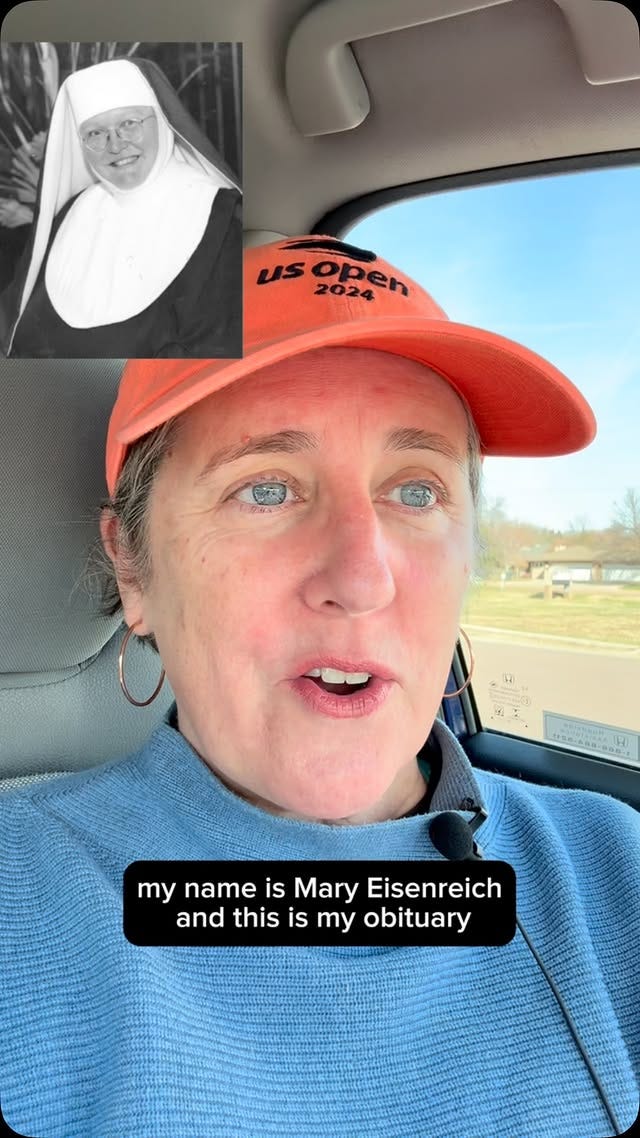When Tears Meet Laughter and Finding the Joy in Our Last Goodbye
Four ideas to create a memorable funeral, including yours.
My husband puts fake parking tickets on cars at funerals—and people thank him for it.
This seemingly odd prank of his got me thinking about how we handle death in our culture. As someone now at the age where I think about my own mortality, I've started questioning our somber traditions.
Recently, my husband and I spoke with friends about our wishes after we die, the most pressing of which is what to do with our bodies. My husband is choosing cremation, and that had been my wish too, that is until I heard about human composting. Terramation is carbon neutral and natural, using microbes and beneficial bacteria to decompose the body in a specially prepared vessel. After about 40 days, the result is some fantastic nutrition-rich soil.
But when they basked about my funeral service, I had some thinking to do. I'm not practicing any faith and no longer align with Catholicism, although I still like some old hymns.
So, where do I go from here?
I want my send-off to be meaningful yet not a downer. I've heard others say they want a big party, to which I respond, “Hey, do you know how sad we're all gonna be when you’re gone?” Maybe we mourners don't want to yuck it up on the day we gather to remember you.
On second thought, a compromise may be in order. We're emotional creatures capable of sadness and joy at the same time.
My husband is highly skilled at lightening the mood. When he attends funerals, he prepares for the after-party, also known as the funeral lunch. He's ready to tell an off-color joke, perform a mind-boggling magic trick, or sneak out to put a fake parking ticket on a bereaved friend's car. You know those joke tickets you find at Spencer's Gifts? He's got 'em, and he's ready for you to bust a gut after you get done being mad. Believe it or not, people are grateful for his attempts to make them laugh.
My husband may be onto something. Grief is heavy, and it's not the only emotion we feel when people die. We're complex beings, and so are our relationships with the dead.
Joy in Mourning Around the World
How other cultures handle death has opened my eyes to different possibilities. In Bali, cremation ceremonies are elaborate, colorful affairs with music, processions, and intricate funeral towers. Balinese people smile during these ceremonies because they believe death frees the soul for its next journey, so they combine reverence with celebration.
In South Korea, families transform cremated remains into vibrant memorial beads displayed in decorative vessels. This practice turns remembrance into something visually stunning that celebrates the person's continued presence in a new form – a far cry from the somber urns we use here in the United States.
The New Orleans jazz funeral tradition brilliantly navigates this emotional terrain – starting with solemn lamentations on the way to the cemetery, then transitioning to jubilant music on the return. This shift from mourning to celebration honors both the loss and the liberation of the soul.
Writing Your Own Story
How do you go about turning your passing into something meaningful? Pre-plan your funeral so everything is laid out for your loved ones, and even go so far as to write your obituary.
People say, "I'll be dead; I don't care what they write/say/do." Well, that's a fib. You care about the well-being and actions of your loved ones when you're gone. That's why you wrote a will, paid off your bills, did a purge of your house, and created an educational savings account for your grandkids.
Love is eternal, even though life on earth is not. We care about the people we leave behind, especially how they feel about us.
Don’t leave anything unsaid.
Consider using your own words to write an obit for the local paper, a funeral home website, or a Facebook post. Highlight the most meaningful parts of your life or accomplishments. Brag about your family. Celebrate the good, the bad, and the ugly by leaving us with your final word.
If writing isn’t your thing, collaborate with a trusted friend to create an obit so you can give feedback.
Great obituaries are inspiring.
, who has her own Substack but whom I initially found on TikTok, reads awesome obits submitted by people all over the country that read like great stories. You can find her handle @tipsfromdeadpeople on Instagram and TikTok.There’s so much to enjoy with this one:
Mary Eisenreich — what a profound pleasure to meet you after death. Keep on singing!!!
Feeling inspired yet, dear reader? You’ve got this! All it takes is a little foresight and planning.
Creating Meaningful Farewells
Now that I've gotten the wheels turning, what kind of a grand send-off do you want?
For years, we've had set ways to say goodbye. During COVID-19, families scaled down or chose not to have final services at all. I can't say I was sad about it. I was tired of impersonal religious ceremonies followed by restaurant lunches. There isn't anything wrong with going the traditional route, but it’s so cookie-cutter.
Something is missing.
I recently attended a Shiva for my friend whose brother had died. Shiva is a seven-day period of mourning in Jewish tradition that follows the burial of a loved one, typically held in the bereaved's home, with prayers said by a rabbi and then some snacks and socializing.
Did someone say snacking and chatting? I love the whole Shiva thing.
My friend offered us a sampling of her brother's favorites, including bourbon, Butterscotch Krimpets, and Philly pretzels.
Sitting Shiva is a tradition I can get behind because it combines all the best things: prayers, food, and community while offering flexibility on when people can visit.
Really almost anything works, and the presentation is up to you. If you think outside the box, you can use your creativity to showcase your personality into your service.
Practical Ideas for Joyful Remembrance
If you're planning a funeral for yourself or a loved one, consider these ideas that welcome both grief and celebration:
Interactive Memory Stations: Create spaces where your people can actively participate in remembrance – perhaps writing messages on biodegradable seed paper to be planted with a memorial tree, contributing to a collaborative art piece, or recording video messages for the family archives.
Personalized Memory Objects: Offer small keepsakes that reflect the person's passions or personality – seed packets of their beloved flowers, recipe cards of their signature dishes, or bookmarks with their favorite quotes. These tangible reminders help mourners carry forward positive memories.
Music to Travel through All the Emotions: Use music to guide attendees through the emotional journey, perhaps starting with reflective pieces during the ceremony and transitioning to the person's signature songs afterward – mirroring the wisdom of the New Orleans jazz funeral tradition.
Memory Sharing Circles: Create dedicated time for attendees to share stories – not just the reverent ones but the funny, quirky moments that capture the person's essence. These stories often bring unexpected moments of laughter and connection.
Holding Space for the Full Spectrum
Maybe my husband is right to bring his fake parking tickets to funerals. He is known to get carried away by also bringing fake snot, fake teeth and fake roaches for others to enjoy. (Don’t ask!)
But the surprise of the ticket, followed by laughter, is precisely the release valve some people need in the heaviness of grief.
It's not about changing the mood but acknowledging that our relationships with the dead contain joy, and our remembrances can also. Incorporating joy doesn't diminish grief but honors the fullness of a well-lived life.
When we allow space for laughter alongside tears, we create funerals that feel authentic to the complex people we've lost and the range of emotions we feel in losing them.
I'm still figuring out exactly what I want for my send-off, but I know this: I want it to reflect the fullness of who I was – the serious and silly parts, the meaningful connections, and the clever quips.
I want my loved ones to feel permission to grieve deeply and laugh freely, sometimes in the same breath.




Ilona, your piece is wonderful, and it made me ponder something I’ve never quite articulated before. We often talk about “closure” in the context of death, but what if closure isn’t about finishing a chapter, but rather about opening a new one? What if our grief isn’t meant to be resolved or completed, but rather integrated into our lives, becoming a part of who we are? What if the goal isn't to “move on,” but to carry the memory of our loved ones with us, allowing it to shape us and influence us in positive ways? Perhaps the most profound act of remembrance isn’t letting go, but learning to hold onto the love and lessons they gave us, even as we navigate life without them. Does grief ever truly end, or does it just evolve into something else?
To each his own. I have two thoughts. When I go over the rainbow bridge to be with the dogs of my past I hope for two things. First, that my remains (ashes) go wherever my wife is. If you can't find her, toss them into the waves off the rocky coast Maine. Or any body of water near you. Composting sounds fascinating, but could be expensive.
Second, no funeral. Nobody should spend a dime on travel or lose a day for my sake. Do something fun or enjoyable instead. Have a party. Make jokes about me. Whatever. Mostly, please don't make a big deal about it.
Move on, do something nice for somebody alive. Adopt a rescue dog! Feed a gold fish. Cook a ribeye steak. Read a book. Enjoy living. I'm gone. So be it. Peace.